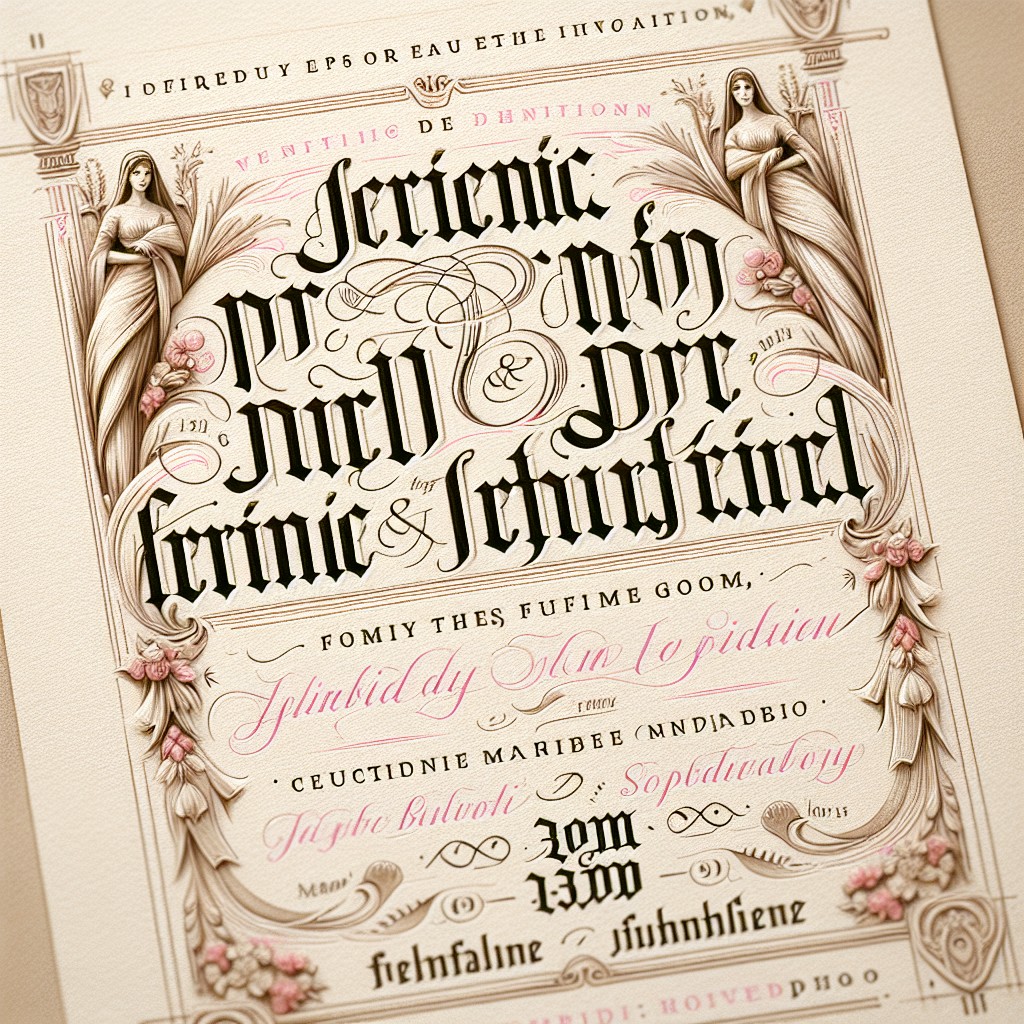Learn the etiquette for whose name should be listed first on a wedding invitation and discover the traditions that influence this decision.
Key takeaways:
- Bride’s name usually listed first on traditional wedding invitations
- Consider the hosting party when deciding whose name goes first
- Same-sex couples have more flexibility in choosing the order
- Divorced and remarried parents can be included with careful consideration
- Modern etiquette allows for personalization and creativity in invitation wording
Traditional Etiquette – Bride’s Name First

Under traditional etiquette rules, the bride’s name typically precedes the groom’s name on wedding invitations. This order reflects the historical notion of ‘presentation’ where the bride is being presented to the groom’s family.
Here are some points to consider:
- The bride’s first and middle names are listed first; the last name is often omitted if it’s the same as her parents’, whose names might appear above as hosts.
- The groom’s full name follows after “to,” signaling the joining of the two parties.
- This format is especially prevalent in heterosexual couples where the bride’s parents are the primary hosts or bear the majority of wedding expenses.
- It’s common practice for the names to be aligned with the hosting party, which traditionally has been the bride’s family.
Remember that adherence to this etiquette is optional, and couples may choose the arrangement that best represents their personal preferences.
Same-Sex Couples – Deciding Whose Name to Place First
For same-sex couples, traditional gender-based etiquette doesn’t apply, offering a chance for more personalization. Consider these factors for a decision that best reflects your partnership:
- Alphabetical Order: For simplicity and fairness, following the alphabet by last name can be an easy solution.
- Symmetry: If one partner has significantly fewer or more names than the other (e.g., middle names), alternating the order can create a balanced design on the invitation.
- Preference: Discuss with your partner if either has a strong preference for going first based on family, cultural, or personal reasons.
- Hosting Party: If one side of the couple’s family is hosting, it may be appropriate to place their name first.
Remember, the key is that the invitation represents the couple equally and respectfully, reflecting the nature of the event as a shared celebration.
Modern Etiquette Variations
Modern sensibilities have inspired couples to tailor wedding invitations to reflect their personalities and preferences. Some opt to list their names alphabetically by last name, while others may choose the order based on the flow and sound of their names together. The importance of whose name appears first has lessened, with some couples placing the name of the partner with a more direct connection to the majority of the guests first.
In cases where one partner or their family has significantly contributed to wedding expenses, it may be customary to honor them by listing their name first. Ultimately, flexibility and personal choice guide modern wedding invitation etiquette, allowing couples to express themselves in a way that feels authentic to them.
Involving Divorced and Remarried Parents in the Invitation Process
Navigating the dynamics of divorced and remarried parents on wedding invitations requires sensitivity and diplomacy. Here are a few pointers to handle this delicately:
- Consider Each Parent’s Involvement: Reflect the involvement of each parent in your life and the wedding itself. If both parents are equally involved, it’s respectful to include both names on the invitation.
- Separate Lines for Each Parent: When parents are divorced and haven’t remained close, list each parent’s name on a separate line, starting with the mother, followed by the father.
- Stepparents: If stepparents play a significant role in your life, you may choose to include their names as well. A simple “and,” followed by the stepparent’s name after the biological parent’s name, is usually appropriate.
- One Family One Line: If your parents are divorced and have not remarried, their names can be listed on the same line, with the word “and” between them, as long as they share a last name. If they have different last names, use separate lines.
- Maintain Equality: When involving multiple sets of parents, avoid ranking one set’s importance over another’s. Strive for equal representation to honor all parents involved.
Remember, the ultimate guide should be what feels most appropriate for your particular family situation and ensuring that all who are instrumental in your life feel valued and acknowledged.
Specific Examples of Wedding Invitation Wording
Considering the nuances previously discussed, here are practical applications for your invitation wording to reflect the appropriate order of names:
1. Traditional Wedding:
“Mr. and Mrs. Jonathan Smith
request the honor of your presence
at the marriage of their daughter
Emily Smith to Michael Brown”
2. Including Both Sets of Parents:
“Mr. and Mrs. Jonathan Smith
and Mr. and Mrs. Albert Brown
invite you to join in the celebration of the marriage
of Emily Smith and Michael Brown”
3. For a Same-Sex Couple:
“Taylor Green and Jordan Ellis
invite you to share in their joy
as they exchange marriage vows”
4. When One Family is Hosting:
“The Smith family
welcomes you to the wedding of
Emily Smith and Michael Brown”
Each example maintains clarity and respect, keeping tradition or modern preference in mind. Tailoring your invitation wording according to your unique situation not only personalizes your event but ensures that your invitations are both informative and elegant.



